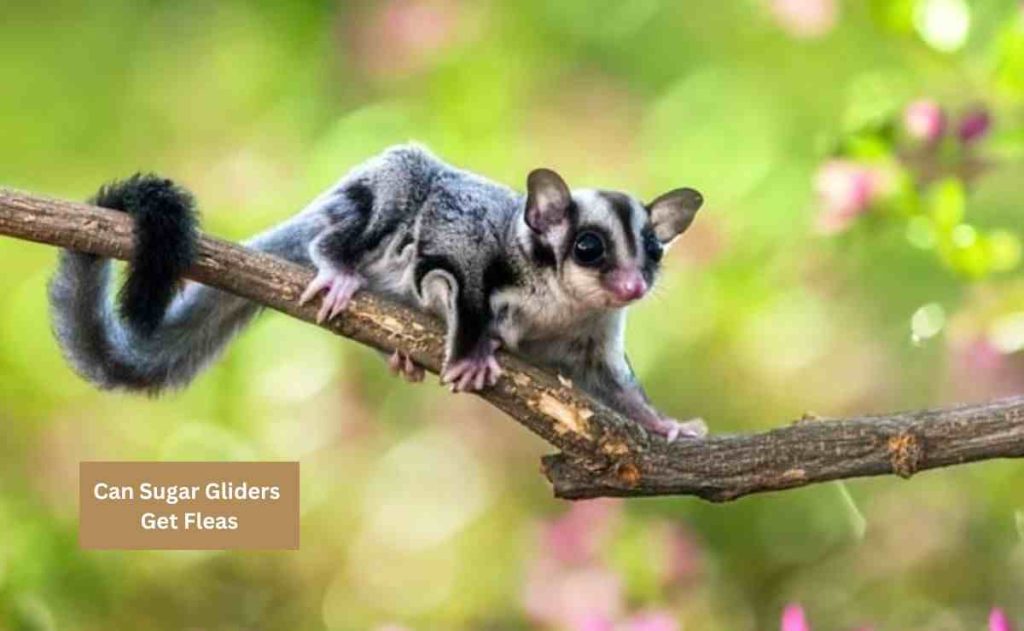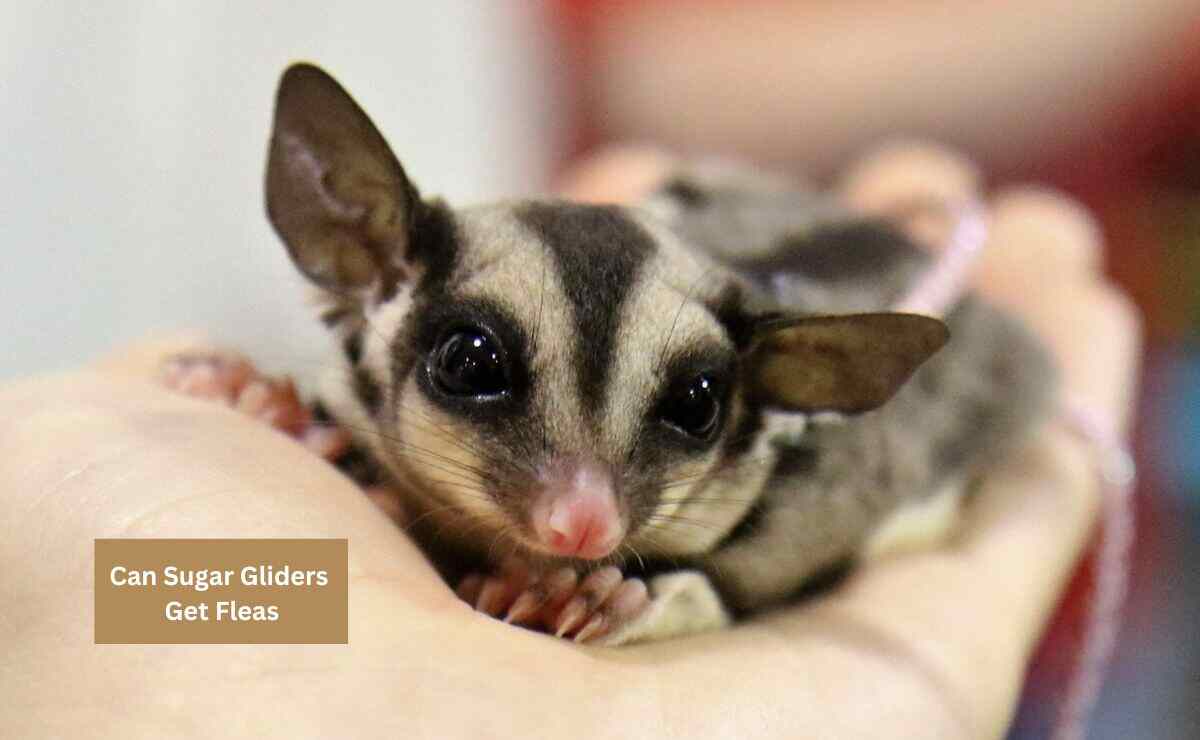Owners of cats and dogs often notice their pets are infested with fleas. So it’s also a common concern for the owners of gliders. You may wonder: can sugar sugar gliders get fleas?
Unfortunately, yes. Sugar gliders can indeed get fleas, just like any other pet. Fleas are small parasites that feed on the blood of animals, and they can cause discomfort and health problems for your sugar glider if left untreated.
Can Sugar Gliders Get Fleas?

Flea infestation in domestic pets is a common disease. So your gliders may have this problem. However, the chances of infection are very minimal. This is because a sugar glider’s fur is thick, making it hard for pests to hide in it.
It’s true that, sugar gliders are not safe from fleas like, ticks, hookworm, and other infestations. Even in thick fur, fleas latch onto your pet gliders and cause various issues.
However, sugar gliders are hypoallergenic pets, so they are less likely to experience allergies. Though they can get infected with fleas in captivity, the chance is less. This is in contrast to sugar gliders in the wild, who are more exposed to various pests. So, it’s a common issue for pet sugar gliders.
How To Know If Sugar Gliders Have Fleas?
Sometimes sugar gliders show some irritation when infested to fleas. If you are confused, then look for these signs:
- Visible on Fur
Inspect your sugar glider’s gray fur closely. Fleas are small, about ⅛-inch long, with a reddish-brown hue. They can jump from one place to another. If you see tiny insects moving around in your glider’s fur, it’s likely a flea infestation.
- Excessive Scratching
If you observe your sugar glider scratching more frequently than usual, it could be a sign of fleas. Fleas cause discomfort and pain when they bite, prompting your pet to scratch to alleviate the irritation.
- Flea Dirt
While you may not directly see the fleas, you might notice tiny, dark flakes on your sugar glider’s fur, bedding, toys, or cage. These flakes, resembling pepper, are flea droppings and indicate a potential flea presence.
A thorough inspection of your home is crucial. Keep an eye out for flea eggs, which are off-white in color. These may fall off from areas the fleas have inhabited, like your pet’s bed or your own bed.
If you spot unusual particles floating around your house, it could be a sign of a flea infestation. Being vigilant about these signs allows you to address a potential flea issue quickly.
What To Do If My Sugar Gliders Have Fleas?
If your sugar gliders have fleas, then first thing you should give them a proper bath using relatively warm water and mild soap. It will eliminate the fleas from their fur. You can use specific shampoo to remove fleas. If you’re considering a flea shampoo, consult your vet first and use it only if approved.
Then run a flea comb through your sugar glider’s fur. This special comb is designed with teeth that attract and trap fleas. Even if your pet doesn’t have fleas, using this comb helps remove flea dirt and droppings from their fur. After use, dip the comb in hot soapy water to kill any lingering fleas.
Do not attempt to crush the fleas. Fleas are quick movers and may jump away before you can eliminate them. The flea comb is effective in trapping them.
You should check regularly the skin and fur of your gliders and ensure your sugar glider doesn’t experience another flea infestation. If your pet has a history of frequent flea attacks, use the flea comb at least once a week as a preventive measure.
Remember to consult your vet for guidance, especially if you are considering using specific flea treatments or shampoos.
How To Keep Your Sugar Glider Free Of Fleas?
Protecting your sugar glider from fleas is crucial, and prevention is key. Firstly, you have to maintain your sugar glider’s grooming routine to ensure cleanliness.
Sugar gliders don’t require frequent bathing, but if you smell bad odor, then you can give occasional baths to them. Use a pet-friendly shampoo that is formulated with safe ingredients for small animals.
Regularly clean your sugar glider’s cage by placing it on a tray with paper bedding, that offers comfort and odor control. Clean the cage sets with a simple rug, dish soap, and water or unscented baby wipes at least twice a week.
After each feeding, clean your sugar glider’s water bottle and bowls thoroughly using warm or hot water and a pet-safe detergent. Rinse them under running water to remove any food particles. Avoid leaving water bowls exposed for too long to prevent attracting pests.
To prevent fleas, make sure to keep your sugar glider’s living area clean and tidy. Regularly clean their cage and bedding, and vacuum the area around their cage to remove any potential flea eggs or larvae.
How To Prevent Fleas From Home?
If you don’t want fleas infection in your sugar gliders, then you should prevent fleas from entering your home. It is the crucial thing to keeping your sugar glider safe. Here are some effective tricks to make your home less hospitable for fleas:
- Keep The Home Clean
Regularly vacuum carpets and throw rugs, focusing on areas where flea eggs, larvae, and pupae might hide. Use a powerful vacuum and, when possible, employ a steam cleaner on carpets and upholstery to eliminate fleas.
- Wash Bedding
Clean your bedding, including your pet’s. You should use hot water to wash and the highest heat setting for drying the bedding. Consider replacing bedding if the infestation is severe.
- Maintain Yard Cleanliness
Mow your lawn regularly, as tall grass provides a favorable environment for fleas. Rake grass clippings and remove debris from flower beds to expose the yard to sunlight, deterring fleas. Spread cedar chips in outdoor areas where your sugar glider frequents.
- Consult Gardening Center
Seek advice from your local gardening center about nematodes, microscopic worms that naturally control flea eggs and larvae. Use nematodes in problematic areas to manage fleas without harming pets or humans.
- Prevention Product
Create a natural flea deterrent by making a lemon spray. Slice 1 to 3 lemons thinly and boil them in at least 12 ounces of water. Let the solution simmer overnight, strain the lemons, and pour the solution into a clean spray bottle. Use this lemon spray on flea-prone areas in your home.
Fleas are more prevalent during the warmer months, but they can survive in cooler temperatures. While cooler temperatures can slow them down, fleas can survive in temperatures as low as 46°F. Therefore, vets commonly advise pet owners to implement preventive measures throughout the year.
There are various flea prevention products available, but it’s crucial to consult with your vet to ensure they are safe for use on your sugar glider. Taking proactive steps year-round can help maintain a flea-free environment and protect the well-being of your pet.
Why is my sugar glider scratching?
If your sugar glider is experiencing itchiness, they start scratching themselves. So there could be various reasons for it:
Fleas or mites are common causes of itching in sugar gliders. If you observe constant scratching, it might be worth checking for these pests.
Stress can lead to self-mutilation in sugar gliders. Factors like fear, anxiety, or perceived threats can contribute to this behavior. Creating a comfortable and calm environment, away from high-traffic or loud areas, can help alleviate stress.
Ensure the temperature is set appropriately. If there is improper condition, then they can scratch. You can use heat lamps, heat pouches, warm bedding, and enrichment toys to create a comfortable living space.
If the itching continues and you suspect fleas, immediate treatment may be necessary. Consult a veterinarian for proper guidance. Dusting with pyrethrin or carbaryl powder is one option for flea treatment.
Conclusion
Fleas attack in sugar gliders is a common occurrence. It mostly happens if you don’t groom your pets regularly. However, sometimes they can infested from outside.
Remember, flea prevention is the key to keeping your sugar glider healthy and comfortable. If you maintain a clean environment and regularly check for fleas, your sugar glider remains flea-free.
Also Read
